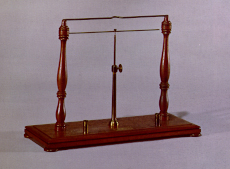
24.2 x 13.2 x 33.5
Steel and mahogany
CAT. 1851 : 19.O.II
Duas agulhas magneticas com um arame ou fio de cobre para transmittir a corrente voltaica. Servem para mostrar a influencia da corrente sobre a direcção da agulha.
Two magnetic needles with a wire or copper thread to transmit the voltaic current. They show the influence of the current on the direction of the needle.
In 1801, Oersted began a series of journeys to Germany and France during the course of which he got to know Ritter. The two of them succeeded in demonstrating the existence of relationships between electrical phenomena, heat, light and chemical effects. They did, however, encounter some difficulties in the attempt to discover a relationship between electricity and magnetism. W. Gilbert, in his work De Magnete in 1660, had stated that electricity and magnetism were two manifestations of a single force inherent to all matter. In 1785, Coulomb had determined the quantitative law governing the interaction between electrically charged bodies, with his electrostatic balance. The qualitative behaviour of static electricity had already been determined by the French physicist, Charles du Fay, in 1733. As a result of Coulomb's studies, the scientific community accepted the independence of magnetic and electrical behaviour manifested by matter, since "magnetic fluids" could never leave a magnetic bar whereas electrical fluids could. Meanwhile, the German school of thought, influenced by the Philosophy of Nature, believed in the unity of all forces and tried to establish a relationship between electricity and magnetism. These studies had a decisive influence on Oersted's research work.
In January 1804, Oersted went back to Denmark where he continued his investigation in Physics and Chemistry. In his work "Research on the Identity of Electrical and Chemical Forces", published in 1812, he suggested that magnetic phenomena were produced by electricity. In 1817, together with Esmark, he built a huge battery with a small internal resistance, with which he carried out several studies on electrical phenomena. In the winter of 1819-1820, when he deliverd a series of talks on electricity, magnetism and galvanism to an audience that already knew about the principles expounded in the Philosophy of Nature, he remarked on the effect of an electrical current on a magnetic needle. Contrary to what was often said, this occurrence was not simply accidental, as he had been working for some years on this problem.
On July 21, 1820, Oersted announced his discovery in an article entitled "Experimenta circa effectum conflictus electriciti in acum magneticam". Some of his experiments are described in this article, as well as some rules for determining the direction of the force on the magnetic pole.
According to Oersted, when two ends of a battery are connected by means of a metal wire, an "electric conflict" is produced in the conductor and the surrounding space, causing the magnetic needle to be deflected.
In the same article, Oersted also stated that "the pole below the point through which the negative electricity enters is moved to the East and the pole above the point through which the negative electricity enters is moved to the West". This observation leads to the conclusion that the "electrical conflict" must describe coaxial circles, with the common axis of these circles coincident with the wire conducting the electricity. Besides this circular movement, there is also a progressive movement over the length of the electrical conductor, a spiral line resulting from the association of these two movements.
Oersted's experiments, using a relatively simple instrument, were enough to rock the foundations of Newtonian Mechanics. The nature of magnetic force was distinct from the forces known until then. It was certainly not a central force, since it was not oriented along a straight line between two interacting points, as happens with gravitational forces, interacting forces between electrical charges at rest, or between the two poles of a magnet.
The Gabinete de Física has two examples of a device to observe the results of Oersted´s experiment.